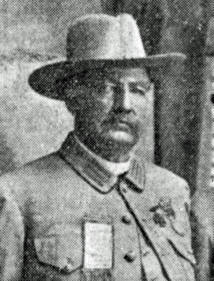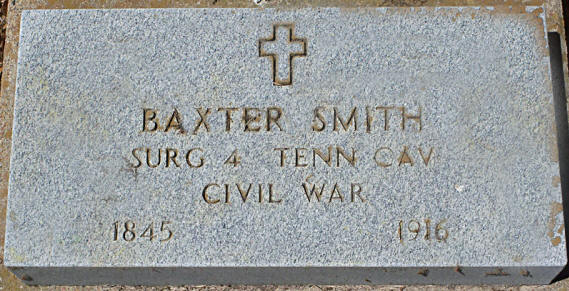|
S |
|
S |
Dr. Baxter Smith
From Saturday’s Daily.
 Dr. Baxter Smith,
noted physician, a learned man and an ex-Confederate soldier, died
in this city yesterday afternoon at 5:20 o’clock and was buried
under the auspices of the E. S. Rugeley Camp Confederate Veterans
this afternoon at 3:30.
Dr. Baxter Smith,
noted physician, a learned man and an ex-Confederate soldier, died
in this city yesterday afternoon at 5:20 o’clock and was buried
under the auspices of the E. S. Rugeley Camp Confederate Veterans
this afternoon at 3:30.
Religious services were conducted by Rev. John Sloane at the Episcopal Church.
Dr. Smith was 70 years and eight months of age at the time of his death and is survived by three sons. Some months ago Dr. Smith red a history of his life to the writer and requested us to publish it when he died. As soon as it can be found we will follow the instructions and give it ot the public.
We know enough to say, however, that Dr. Smith descended from one of the old aristocratic families of Alabama. His mother was one of the foremost of Southern women and at one time was immensely wealthy and influential. She lavished upon her son (the subject of this sketch) all the polish and education money could buy, graduating him at the Tulane Medical College of New Orleans, and sending him to Berlin, Paris and other European educational centers for additional training in the medical colleges of Europe.
When the war broke out Dr. Smith returned home and entered the service of his country, serving gallantly and with honor throughout the struggle.
Dr. Smith possessed a wonderful mind and memory and at one time was considered one of the foremost and most learned physicians in South Texas. His acquaintanceship was broad, his practice of former years especially taking him over all the section of the State south of Houston.
During the past several months the doctor has been the victim of cancer. All that friends and associates could do for him was done, but to no avail. He was sent to New Orleans and later to Baltimore to scientists, but his trouble gradually grew worse, resulting in his death yesterday.
Peace to the ashes of so great a mind. May his soul rest in peace in the Great Beyond.
Matagorda County
Tribune, September 1, 1916
Confederate group marker photo
Art Treasure Sold to
Save His Life; Dr. Bat Smith Dies
Dr. Bat Smith of Bay City sacrificed a picture that was very dear to his heart to save his life.
The picture now hangs in the Houston Art League, where all the people may see it, but Saturday at Bay City Dr. Smith was buried. His sacrifice had been in vain.
The picture that hangs in the Art League is an ivory portraiture entitled “A Boy in a Dell.” It was purchased from Dr. Bat Smith for $259 raised by popular subscription. The piece of ivory is said to have cost Dr. Smith $4100 many years ago. It was painted by G. H. Hite, an American artist, in 1855. It shows the marked differences in the art work of ante bellum days and now.
But to Dr. Smith the picture had another value—for the boy in the dell is no other than a young brother of his who died many years ago.
Dr. Smith was forced to part with the picture that he might go to Baltimore and have an operation performed for cancer.
He went last April, after receiving the money for the picture. He died Friday.—Chronicle.
Matagorda County
Tribune?, Friday, September 1, 1916
Tribute to Memory of
Dr. Bat Smith
By E. S. Rugeley Camp, Confederate Veterans.
 Whereas the Angel of
Death on August 25, 1916, again invaded the E. S. Rugeley camp of
Confederate Veterans and took from us our friend and comrade, Dr.
Bat Smith.
Whereas the Angel of
Death on August 25, 1916, again invaded the E. S. Rugeley camp of
Confederate Veterans and took from us our friend and comrade, Dr.
Bat Smith.
BE IT RESOLVED, That the death of Dr. Bat Smith was particularly sad and even tragic;
Born in Alabama in the year 1845 of one of the most distinguished and wealthiest families in that great State, educated in Europe, in both Germany and France, he became a splendidly educated man, and building on this early foundation by intense mental industry he read hard nd continuously and became with him most remarkable memory to aid him, he was in deed and in truth a learned man. He loved life and the good things of life and enjoyed them from the cradle to the grave.
After the war broke out, I do not know the year, but think it was in the fall of 1862, he ran the blockade, returned to his home in Mobile, Ala., and entered the armies of the Confederate States, joining Forrest’s cavalry with which he remained until the end of the war. He was wounded on the retreat from Atlanta. As a soldier, he at all times did his full duty cheerfully and willingly.
At the end of the war he went to New Orleans to the Tulane Medical College and remained there three years, when he graduated, second in his class with high honors. After his graduation he returned to Alabama, where, at Mobile, in 1868, he married Miss Dabney, a refined and cultured lady and a member of an old Virginia family of that name and a grand-niece of Patrick Henry.
After his marriage he emigrated from Alabama to Texas and located at or near Columbus in Colorado County, where he became a noted physician and surgeon, his fame as such covering all Texas. At one time he was president of the Texas Medical Association, wherein none stood higher.
He was also a surgeon in the U. S. army during the Spanish-American war in Cuba. At Havana his medical services were so distinguished as to win for him praise and commendations from Gen. Leonard Wood. After the Spanish-American war he returned to Texas, locating in Matagorda County, at Bay City, where he remained until his death, August 25, from cancer of the throat, in the 71st year of his age.
May his soul rest in peace with the God who gave it.
His mind was the finest I have ever known.
A Comrade.
Matagorda County Tribune, October 13, 1916
Mrs. Helen Dabney Smith
The Ed S. Rugeley Chapter, U. D. C., of Bay City, Tex., reports the death of a much loved member, Mrs. Helen Moore Dabney, wife of Dr. Baxter Smith, on the 24th of February. She was born in Fredericksburg, Va., in 1844, and was the daughter of John Milton Dabney and Elizabeth Taylor Moore, who was a great granddaughter of Patrick Henry. Through her mother Mrs. Smith was also a descendant of the Colonial Governor of Virginia, Sir Alexander Spottswood, whose daughter, Catherine, married Bernard Moore, of Chelsea, on York River, Virginia. The name of this old home was taken from Chelsea on the Thames, the home of Bernard Moore's great grandfather, the celebrated Sir Thomas More, Lord High Chancellor of England under Henry VIII.
Mrs. Smith formerly lived at Wharton, Tex., where she was a member of the J. E. B. Stuart Chapter, but later removed to Bay City. She was an earnest worker in the U. D. C., devoted to the old soldiers of the South, and noted for her good work in Church circles. Resolutions of tender sympathy with the family and friends were passed by her Chapter. The Confederate Veterans and Daughters of the Confederacy took part in the burial services. The casket was covered with the Confederate flag and many beautiful floral offerings.
Courtesy of Emiko Lanier
Resolutions of Respect
By the E. S. Rugeley Chapter of U. D. C. Number 542, of Bay City, Texas
Whereas, it has pleased Almighty God to remove from our midst and chapter Helen Moore Dabney, beloved wife of Dr. Baxter Smith, who was born at Fredericksburg, Va., on teh 16th day of October, 1844. She was the daughter of John Milton Dabney and his wife, Elizabeth Taylor Moore, who was the great granddaughter of Patrick Henry.
Through her mother, Mrs. Smith was a descendant of the Colonial governor of Virginia, Sir Alexander Spottswood, appointee by Queen Anne in 1703, and whose daughter, Catherine married Bernard Moore of Chelsea on York River, Virginia. The old home of the family was named after Bernard Moore's great grandfather (Chelsea on the Thames in England), the celebrated Sir Thomas More, Lord High Chancellor of England in the reign of Henry VIII.
Line may of the old Virginia families that of our deceased sister was closely allied to many illustrious characters in the history of England and Scotland and America. Mrs. Smith was a member of the J. E. B. Stuart Chapter of Wharton, and after moving to Bay City, was transferred to this one. She was an earnest working in the cause of the Daughters of teh Confederacy and dearly loved the old soldiers of the South, ever having a kind and gentle word for them wherever and whenever she met them, whether of high or low degree.
For several years she was president of the Ladies Guild of St. Marks Episcopal church, and all who knew her can attest her good work in the Master's cause. Her kind and gentle disposition made her a favorite with old and young alike wherever she lived. She was a true woman of the Old South, proud of the land that gave her birth, loyal to her native state, Virginia, and to the home of her adoption, Texas; loyal to her friends. loyal to her people and loyal to her church and one of her most prominent traits of character was the almost child-like faith that she had to the infinite love and mercy of a just and all-wise God.
Therefore be it Resolved--
First: That the Chapter has lost one of its most useful and untiring members as well as one who was fully in sympathy with the work, being one of a family who gave nearly their all to the Lost Cause and one who could tell many interesting occurrences of teh dark, ad days of that awful carnage.
Second: That we tender to the desolate and lonely husband and sons our heartfelt sympathy and sorrow for them in their bereavement, and that a copy of these resolutions be sent to them; also to Mrs. Powell, a sister of Mrs. Smith, and to the Wharton Chapter.
Third: That a copy of these resolutions be spread upon the minutes and a page be devoted thereto. Also that copies be sent to the Houston
Matagorda County Tribune, March 17, 1911